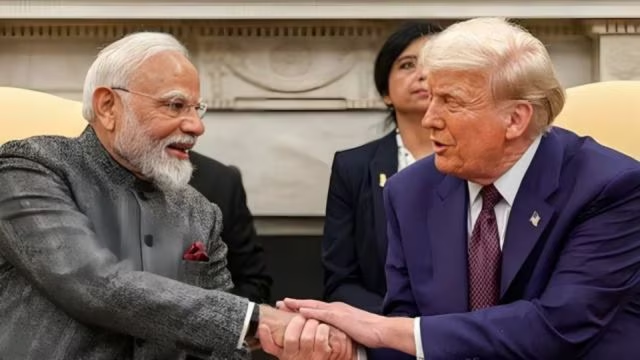Tariffs Rising, Ties Resilient: Modi ‘Deeply Appreciates’ Trump’s Positive Take

Image via The Indian Express
Prime Minister Narendra Modi said he “deeply appreciate[s]” and will “fully reciprocate” former US President Donald Trump’s “positive assessment” of India–US relations, even as bilateral trade faces fresh tariff headwinds. The calibrated response signals New Delhi’s intent to ring‑fence the broader strategic partnership from short‑term trade frictions and keep dialogue channels open.
What PM Modi Said
PM Modi acknowledged Trump’s remarks on the trajectory of India–US ties, framing them as a reaffirmation of mutual goodwill. By coupling “deep appreciation” with “full reciprocation,” he indicated:
- A willingness to sustain high‑level engagement despite tariff noise
- Continuity in strategic cooperation across defense, tech, and critical supply chains
- A preference for resolving trade issues through negotiated pathways rather than escalation
The Immediate Context: Tariff Tensions
Recent tariff moves out of Washington have unsettled parts of India’s export ecosystem. The near‑term effects include:
- Price renegotiations and delayed orders in price‑sensitive categories
- Margin pressure for MSME exporters in textiles, leather, and select engineering goods
- A watchful stance from markets on the rupee and earnings guidance Against this backdrop, conciliatory messaging helps stabilize expectations while technical talks proceed.
What Trump Signaled
Trump’s “positive assessment” of India–US ties, as referenced by Modi, underscores:
- Enduring bipartisan recognition of India’s strategic role in the Indo‑Pacific
- A shared interest in resilient supply chains and technology cooperation
- Political space in Washington to separate geo‑strategic alignment from transactional trade spats
Why The Words Matter
Statements from principals shape negotiating atmospherics. Modi’s response:
- Lowers the temperature around tariffs and frames them as solvable
- Reassures industry and diaspora networks that channels remain open
- Positions New Delhi as a steady partner focused on long‑term convergence
Diplomatic Playbook: Strategic Convergence, Trade Compartmentalized
Expect New Delhi to:
- Keep defense, maritime security, and intel cooperation on their own track
- Advance iCET (critical and emerging tech), semiconductors, and space projects
- Use targeted trade dialogues to handle tariff classification, exclusions, and standards
- Avoid retaliatory spirals while reserving legal options at the WTO as needed
Trade Track: What Could Be On The Table
Technical fixes often soften tariff shocks without headline reversals:
- Product‑level exclusions or quota windows for critical inputs and intermediates
- Clearer rules‑of‑origin and faster rulings on reclassification disputes
- Regulatory cooperation on pharma, med‑tech, and agri‑standards to reduce non‑tariff frictions
- Mobility and services facilitation to offset goods‑trade pressures
- Joint supply‑chain financing or guarantees for strategic sectors (electronics, renewables)
Sectors Watching Closely
- Textiles and apparel: Thin margins; seeking carve‑outs or phased compliance
- Leather/footwear: Price‑sensitive retail; vulnerable to order deferrals
- Engineering goods: Scope for spec changes and origin planning
- Specialty chemicals and pharma: Standards cooperation can preserve access
- Electronics/IT hardware: Exposure via components and final assembly
- IT services: Indirect risk via US discretionary budgets; relationships remain sticky
Markets And Rupee Lens
- A measured rupee depreciation can cushion exporters’ dollar revenues
- Equities may price a temporary margin drag for export‑heavy mid/small caps
- Bonds steady if imported inflation from tariffs remains limited; oil and food remain larger CPI drivers
Diaspora And Political Optics
Indian‑American networks and business chambers act as informal shock absorbers:
- Back‑channel advocacy for reasonable timelines and exclusions
- Maintaining a pro‑partnership narrative during policy turbulence Positive top‑line messaging helps these constituencies sustain outreach.
Defense, Tech, And Critical Minerals
Even amid trade friction, cooperation tracks are expanding:
- Co‑development/production in defense platforms and MRO ecosystems
- Semiconductor design talent, ATMP/OSAT pilots, and supply‑chain mapping
- Space launch services, commercial EO, and deep‑space collaboration
- Critical minerals offtake and processing partnerships to de‑risk dependencies
India’s Likely Next Steps
- Intensify quiet technical talks for product‑specific relief
- Speed GST refunds, expand export credit, and cut select input duties to protect margins
- Calibrate rupee management to absorb part of the shock while curbing volatility
- Use standards and regulatory dialogues to clear non‑tariff bottlenecks
- Keep WTO options ready without foreclosing negotiated settlements
What Washington Might Look For
- Continued market access and predictable policy for US firms in India
- Progress on data, digital trade facilitation, and IP enforcement
- Alignment on supply‑chain security in high‑tech and critical infrastructure
- Movement on standards equivalence to ease compliance costs
Risks That Could Upset The Thaw
- A tit‑for‑tat tariff cycle or sudden non‑tariff barriers
- Sharp US growth slowdown impacting demand and services budgets
- Currency volatility misread as “manipulation” amid political rhetoric
- Simultaneous commodity spikes that compress corporate margins
Reasons For Cautious Optimism
- Deepening strategic alignment in the Indo‑Pacific
- Strong corporate ties, especially in tech and pharma
- Supply‑chain China+1 dynamics favoring India’s capacity additions
- Proven ability of both sides to ring‑fence security and tech from trade flare‑ups
What Businesses Should Do Now
- Map US exposure by HS code; validate classifications and origin documentation
- Engage buyers early on price, lead times, and spec tweaks
- Explore exclusions, rulings, and bonded warehousing to time entries
- Hedge near‑term receivables; tighten working‑capital cycles
- Diversify demand pipelines toward Middle East, EU, ASEAN, and Africa
- Strengthen compliance to avoid routing strategies that lack substance
What To Watch Next
- Any White House/USTR signals on product‑level exclusions or phased implementation
- India’s facilitation steps: credit lines, input duty tweaks, and port logistics
- Sector‑wise export prints to the US over the next 1–3 months
- Guidance from listed exporters on margins and order books
- Updates on iCET, semiconductor projects, and defense co‑production timelines
- High‑level meeting schedules and joint statements that reaffirm separation of trade and strategic tracks
Modi’s “deeply appreciate, fully reciprocate” line is a classic stabilizer: it banks goodwill, reassures stakeholders, and buys time for negotiators to work through the tariff tangle—without derailing the wider India–US partnership.